
April 2018; From Failure to Freedom
Wisconsin is at the forefront of the battle to educate black and brown students. Though access to equal education is defined in the state’s constitution and confirmed by its Supreme Court, the reality is that the proclivity to police black and brown bodies follows the students into schools and undermine their fundamental right to education.
According to a new report titled “From Failure to Freedom: Dismantling Milwaukee’s School-to-Prison Pipeline with the Youth Power Agenda,” Milwaukee exemplifies the school-to-prison pipeline. The report describes the phenomena this way:
The presence of police officers, guns, handcuffs, and metal detectors in schools creates hostile teaching and learning environments that are reinforced by harsh, punitive, and exclusionary school discipline policies. Police brutality, arrests, suspensions, and expulsions are all too common features of the educational experiences of students of color from low-income communities. These policies and practices also have detrimental psychological impacts on youth of color, for whom school resemble prisons more than they do environments that stimulate learning and creativity. High rates of permanent drop out as well as ongoing, and often escalating, entanglements in the criminal legal system result from these policies.
In the 2013–14 school year, Black students at Milwaukee Public Schools accounted for 55 percent of the population but almost 85 percent of “referrals to law enforcement.” Students with disabilities did not fare any better; despite being 20 percent of the enrolled population, they accounted for 91 percent of restrained or isolated students.
In the 2015–16 school year, MPS suspended one out of three ninth-graders, more than four times the national average and expelled 181 students, twice the national average.
The report found that this is supported by vague offenses or minor misbehavior outlined in its Parent/Student Handbook on Rights, Responsibilities, and Discipline, mostly by allowing interpretation of what it calls “inappropriate.” This includes dress, personal property, or use of electronics.
In order to do this, Milwaukee has to ignore a lot of data that shows that not only does this punitive approach to discipline not work—the schools are no safer for them—it also wastes the city lots of money. Milwaukee pays four million dollars a year to keep this punitive system in place. According to the report, direct costs include:
Sign up for our free newsletters
Subscribe to NPQ's newsletters to have our top stories delivered directly to your inbox.
By signing up, you agree to our privacy policy and terms of use, and to receive messages from NPQ and our partners.
- $1,120,898: Police Officer Program in Schools
- $60,000: External School Police Squads
- $435,000: Truancy Abatement and Burglary Suppression Officers
- $122,000: Adjudication of Truancy Citations
- $76,000: Installation of X-Ray Machines
- $51,000: Maintenance of X-Ray Machines
- $13.7 million: Safety Assistants for MPS
- Detentions and Juvenile Court
Indirect costs have also been calculated: “According to a national study by the Center for Civil Rights and Remedies at University of California Los Angeles (UCLA), suspended students graduated at a rate of around 15 percent below their classmates who were not suspended. UCLA estimated that for each student who drops out, the social and fiscal impact is as much as $600,000 over the course of a student’s lifetime.” The report finds that punitive discipline even negatively affects the school performance of non-suspended students.
An investigation by the Office for Civil Rights found that, “Over the course of two school years, federal investigators identified ‘over one hundred incidents at the District’s schools where [B]lack students were expelled, while similarly-situated white students were suspended fort similar conduct.’”
It concluded that “the evidence did not demonstrate that the District has in place effective safeguards to monitor the exercise of discretion in referrals and imposition of sanctions to ensure that it is nondiscriminatory.”
The report summarizes this as an investment in failure and notes that restorative approaches have been found to offer equitable and supportive practices that improve school climate and reduce discipline infractions.
Milwaukee apparently has tried to implement restorative practices but has underfunded them and is using them along with punitive practices, which doesn’t work very well. It continues to prioritize funding for punitive discipline.
The report proposes a Youth Power Agenda, which divests from failure…
- removing police and metal detectors from schools
- ending suspensions, expulsions, arrests, and citations
- ending the use of seclusion and restraints
…and invests in freedom.
- create inclusive school code
- implement robust restorative justice practices
- increase the number of support professional
- reduce class size
- provide culturally-responsive education and training
- collect accurate discipline data
- invest in universal, high-quality early childhood education
- create universal youth jobs program
Black students are fighting for the freedom to thrive.—Cyndi Suarez













